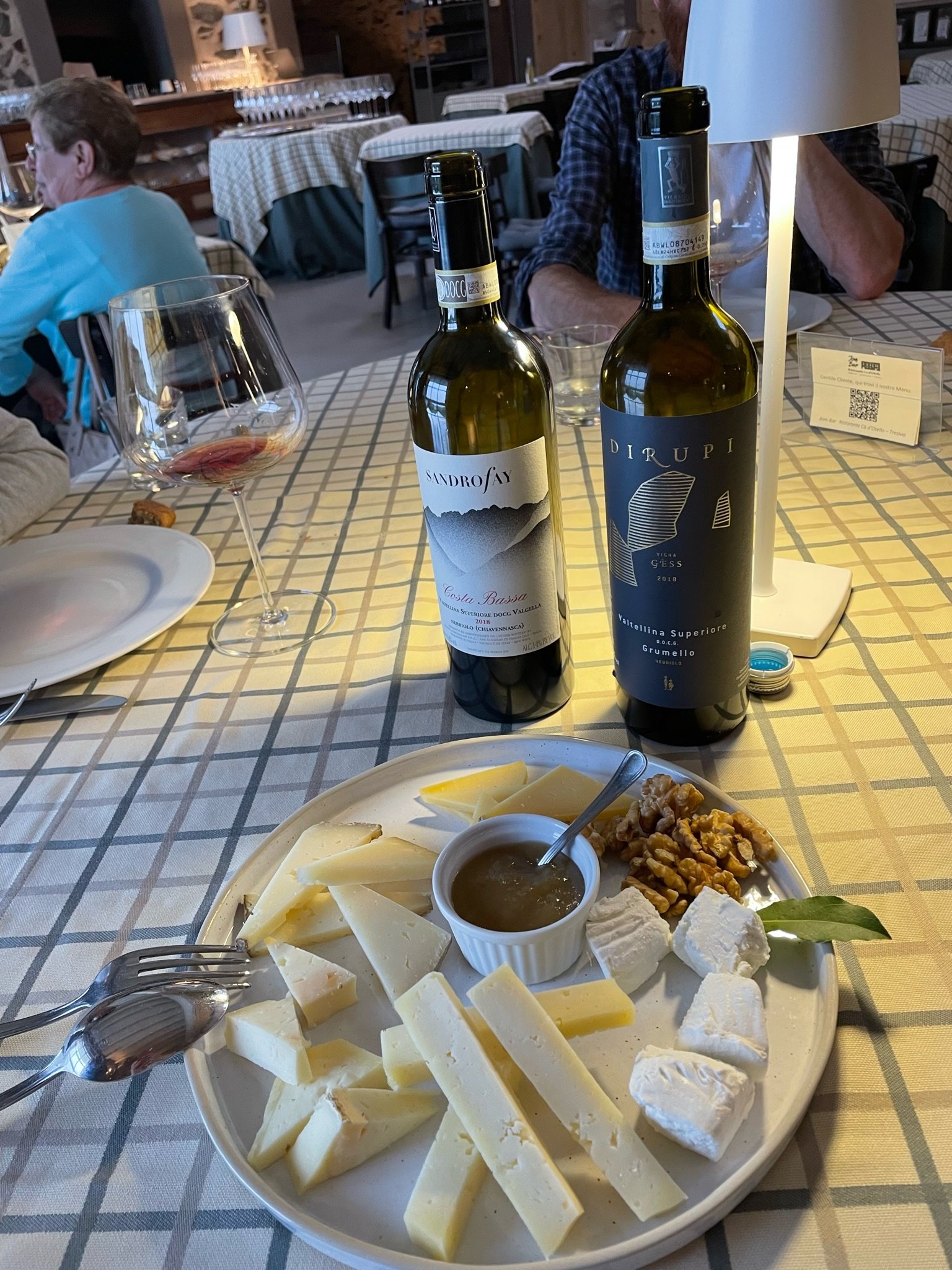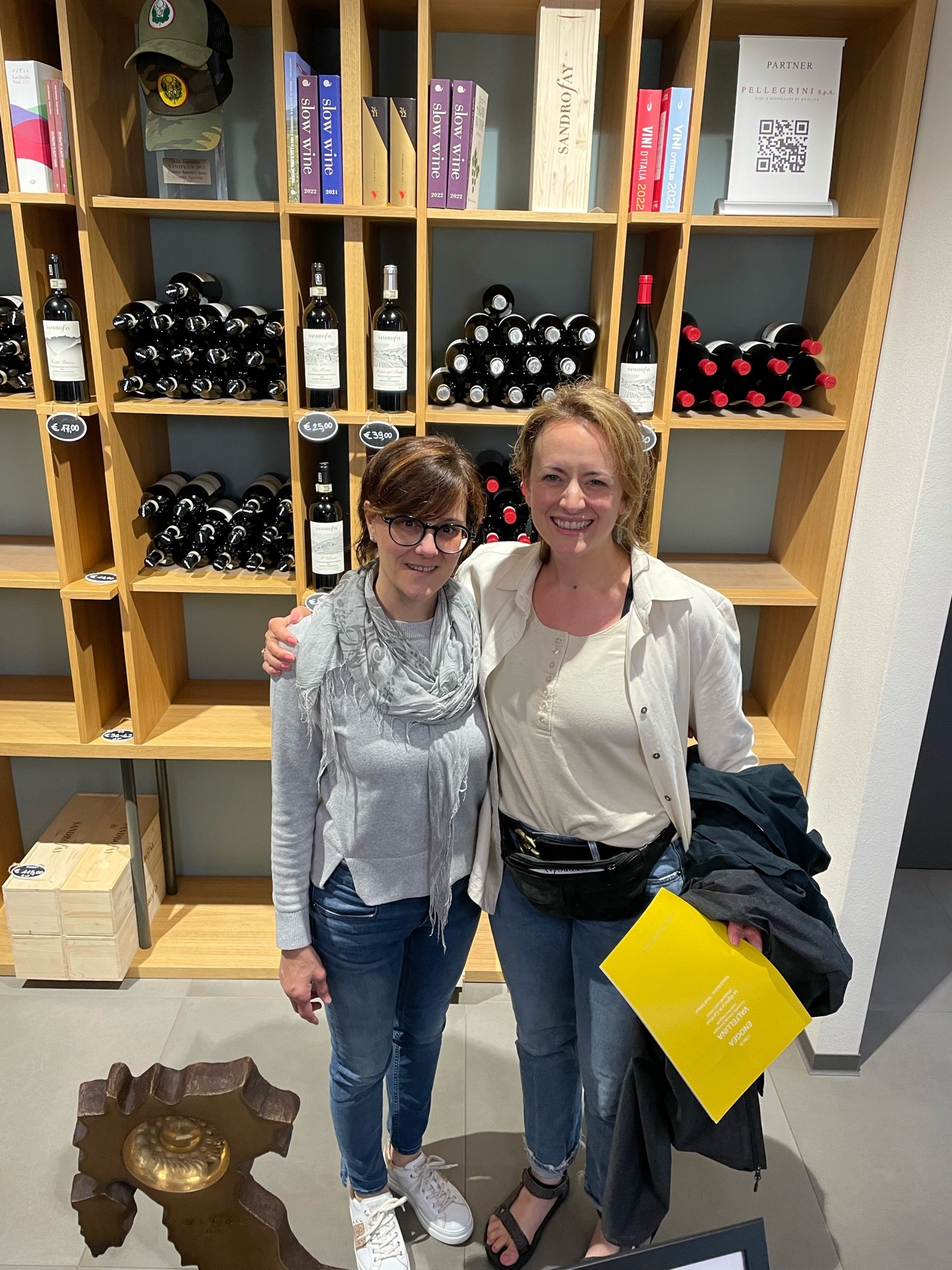Visiting the Valtellina! 🍷
Ciao! It’s Susan, your resident wine lady here. My husband Leo and I had the pleasure of visiting the lesser known Nebbiolo-land on our honeymoon this past June: the Valtellina! We wanted a bit of an adventure and driving our rental car to one of the more remote winemaking areas of Italy was the perfect non-posh, non-Piedmont experience we were hoping for, thanks to the warm welcomes at the wineries Dirupi and Sandro Fay.
Dirupi has been a wine crush of mine since we opened our shop in 2015. Davide Fasolini, who goes by Faso, and Pierpaolo Di Franco, nicknamed Birba, are the two friends who opened the winery in the early ots. Faso and Birba own about 7 hectares, comprising 21 differing plots in Valtellina, a valley within the region of Lombardy that boasts some of the most dramatic vineyard landscapes in the world. Valtellina is a long, serpentine alpine valley bordering Switzerland with about 60 active wine producers known for producing the variety Chiavennasca, known outside of Valtellina as Nebbiolo. It is one of Italy’s smallest wine producing areas, with only about 15 miles of vines on either side of the town of Sondrio, which is where Leo maneuvered our rental car over small, extremely high dirt roads overlooking the Adda River. We met Faso at a slightly treacherous scenic overlook, who was all smiles, tall, redheaded and bearded, donning jeans, a white t-shirt, and royal blue round spectacles.
After a few espresso at the local café, we began walking up the mountainside quilted with rows upon rows of grapevines. As we climbed ancient stone steps from Roman times, we took in the view: vines cascaded down the steep slope, and across the valley was a huge mountain with the sun barely peeking out from behind its black-forested top. Faso explained that Dirupi covers four DOCG areas including Gromello, Sassella, Inferno, and Vergella. Later on when we tasted through the line-up of their wine, Dirupi Grumello was one of my favorites, as well as Leo’s, with its rich, dark fruit notes, and aromas of spice, wood, and cherries.
Faso believes that the perfect climate for Nebbiolo lies between 450-650m of elevation (Dirupi’s vines are all planted between 390-800m) and he explained that the lower elevation in the valley is humid and cold, producing thinner skins on the grapes, and at higher altitude, the vines produce thicker grape skins. One statistic that Faso shared is that it takes about 1500 hours per hectare per year for a total of 100 workers in the Valtellina. If that seems like a lot of labor, it is! Valtellina is extremely steep, and not easy to prune, manage, and harvest. Faso’s favorite time of the year, besides harvest, is being knee-deep in snow, when the land is quiet and calm, and he is tending to his vines. Now that’s love!
Faso and Birba use a combination of resin, coppers and sulfur, and meticulous pruning, and ascribe to the philosophy of ”‘if you want wine, just like in fashion, you have to have slight imperfections. If something is perfect, what’s the fun in it?” Faso also said with a smile, “Do what the plants do, and do it piano piano.” Slowly, slowly. To make good wine, the wine game is a crawl, not a race.
The vineyard tour and subsequent cellar visit, which is located in a 16th century medieval stone fortress, had worked our appetites up a bit, and we headed to lunch where Faso introduced us to Elena Fay, one of the owners, and daughter of the founder at Sandro Fay. Elena was kind-eyed and petite, and easy to talk to in both Italian and English. Leo and I were treated to lunch at her husband’s restaurant, the newly renovated Ristorante Ca d’Otello, located in Tresivio, a small town just outside of Sondrio. Highlights were the bresaola on the personalized charcuterie boards, and a huge portion of pizzoccheri, a hearty, regional pasta dish made with buckwheat flour pasta, cabbage and potatoes, and topped with plenty of grated Parmigiano Reggiano and Valtellina Casera cheese and garlicky melted butter. I was excited to try the famous Valtenesi Bitto, a salty, nutty, firm, cow’s milk local cheese made in huge wheels only in Valtellina. (After our winery visits, I tried three more bites of Bitto, from three different aged wheels, at the famous store Fratelli Ciapponi, in their cheese cave built in 1883.)
In the early 1970s, Elena’s father Sandro Fay began his winery with selected vineyards on Valtellina’s steep mountain sides. Today, Elena and Marco, Elena’s brother, run the esteemed winery. Marco poked his head into the pristine tasting room as we tasted a line-up of six different wines, and we congratulated Marco on getting married the following weekend, which was being held at their family restaurant where we had just enjoyed lunch. Elena was excited to show us a wheel of Bitto that had been inscribed with the Sandro Fay logo, a wheel that they were going to crack on the wedding day.
A few days after our Valtellina tour, Leo and I would drive to Piedmont, which is considered by many as the best region for Nebbiolo in Italy. Yet, after visiting the mountainous, magical Valtellina, it’s impossible to dismiss such a special valley with its beautiful wine and people. Perhaps Lombardy produces the best Nebbiolo? Leo and I would concur.
Thank you to Faso, Elena, Marco, Sandro, Birba and Alejandro (D&P Selezioni) for making this visit happen, and for this unforgettable honeymoon and wine experience! (Scroll down for photos from our trip!)





















